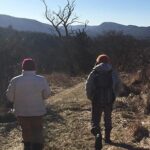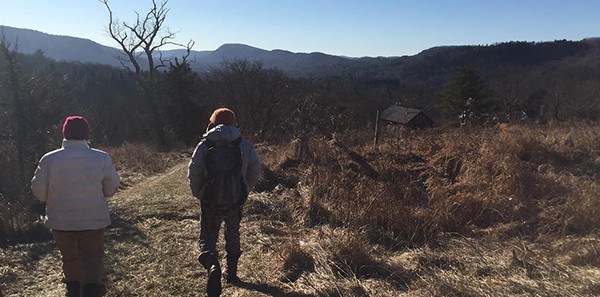Thursday, April 4, 2019 | 28th Adar II, 5779
Dear All,
I had asked Janna, Rebecca, and Shamu – leaders of our Adamah program – to write something for all of us, about the new land we have been able to buy at 181 Beebe Hill Road, contiguous with our existing Adamah land at Isabella Freedman. They’ve written an extraordinarily beautiful piece, and I hope you enjoy it and are inspired by it as much as I am. In the Jewish tradition of fractal sevens, between the seven days of Shabbat and the seven years of shmita, we have sefirat ha’omer, seven weeks of seven, starting the second night of Pesach. Seder night – just two weeks from now – is our gateway to this journey. I hope that what they have written offers wisdom for all of us.
Shabbat shalom, chodesh tov,
Nigel
“Our design at 181 deepens the resilience of our farm while nurturing the land and a community. And maybe it will offer inspiration to you ahead of Pesach…”
As we walked on the new land across crusty snow this January, we were tempted to shout out and point: Put fences here! Plant trees there! Fix that shed! Till that flat area! It is easy and so tempting to project our desires on what we might imagine as a blank slate of available land.
But what we learn from the wisdom of Shabbat and shmita, from Moses pausing and noticing at the burning bush, from the act of reciting blessings, from the wisdom of permaculture and indigenous ways of living on this land for generations before us, is:
pause;
notice.
And observe before we make any changes, to get to know a place before we inhabit it.
(And this may be true for all of us, in our lives – even if we didn’t just become trustees of a new piece of land…)
So we took a deep breath.
As the new “owners”, which is to say, in fact, as trustees of this land, and as a people long rooted in landscape, history, and diaspora it is aleynu – on us – to work to uncover the nature of this land, its past and its present, and figure out how it informs our choices today and in the future. That past includes local dairy and hay farmers who are still our neighbors, and the mostly-erased past of Native peoples. And what’s our plan towards the next shmita year in 2021-22, and then the next full seven-year cycle after that, and after that?
The history in our little corner of Falls Village mirrors broader patterns across the continent. Indigenous communities going back many generations used slash and burn techniques to create abundant edge habitats for foraging and hunting and to produce fertile ground for growing crops. Sheep dominated this landscape in the 19th century, and dairy cows in the 20th. And to some degree, the land follows the plate; wild plants, animals, and the three sisters of corn, beans, and squash were at the center of the diets of native peoples while meat and dairy have been at the center of the diets of affluent Americans in the centuries since property lines were drawn. Forests have been pushed back and grass and corn became king.
Today we have new questions and new imperatives.
Does climate change, with its associated imperative to sequester carbon, reduce meat consumption, and tend habitat for wildlife call on us to reforest parts of the land?
Might walnuts and hazelnuts be part of the vision for a more perennial, less intensive way of feeding ourselves that builds carbon, habitat, and protein?
How can we deepen the resilience of the farming we are already doing on Beebe Hill? Can we move our compost operation to the flat pad that once held a hundred dairy cattle, opening up suitable vegetable growing ground? Should the brushy hillside become a playground for meat goats or should it be reseeded for hay production?
As humble members of the place we like to call “The Interdependent Republic of Housitonica,” named after our watershed, we are grateful to be in a design phase that allows us to sit with the questions.
Shmita, the seventh year of rest that mirrors Shabbat, the seventh day of rest, is both an inspiration and a design principle for us. While it is not a legally binding law outside of Israel, the spirit of the law is powerful. In the seventh year, because our tradition teaches not to sow or harvest, perennial and wild foods become central. Debts are forgiven, and private property is erased. How can we invite wide access to our land and food to counter the myriad damages of private property or unfettered capitalism that the Torah rails against? Shmita literally means ‘release,’ which reminds all of us to loosen our hold on land, money, ideas, possessions, and other people.
The design process challenges us to marry our goals with the ecological details of the land, to weave goat pasture and pollinator habitat, erosion control and vegetable beds, vehicle access and a multispecies orchard. The design process challenges us to ‘think like a mountain’, as Aldo Leopold wrote: to embrace a vision of the land that is long-term and places humans in the land, but not at the center.
So this year of design we will:
- Observe patterns of water flow and deer movements
- Talk to past farmers of the property
- Gather on the land for song, prayer, and learning
- Work with the Natural Resource Conservation Service of the Department of Agriculture to repair past damage through erosion control and water conservation
- Start mapping the land
- Rotate our goats onto parts of the new land
- Introduce Adamah Fellows and Isabella Freedman guests to the land and the design process
The address of the new property is 181. As tempted as we are to find a new farm name (and we might) we are enjoying the symmetry of two 18s, read from the right or the left (we are deeply committed to pluralism in all its forms, after all.) The Hebrew numerical equivalent of 18 is the word ‘chai’, ‘life’.
So we invite you to visit us and to experiment with these ideas and questions in your own life and backyard.
- Learn about the Indigenous history of a piece of land that you’re in relationship with
- Read “Braiding Sweetgrass” by Robin Wall Kimmerer
- Explore Shmita, the Sabbatical Year
- Visit us and tell your friends about Adamah
Shamu Sadeh, Janna Siller, and Rebecca Bloomfield
Adamah Staff

